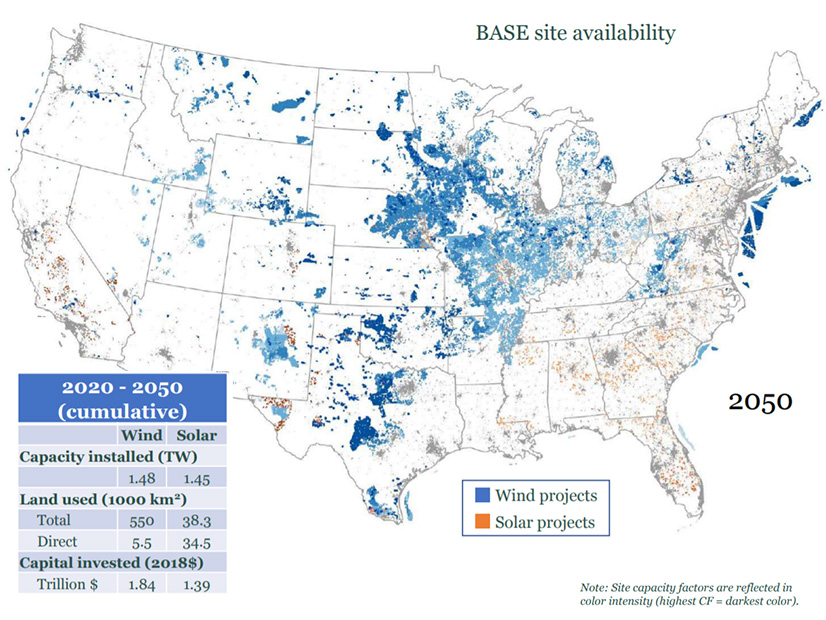Texas: Two Imperatives
There are two imperatives at work: (1) interregional reliability value and (2) interregional renewable integration value.
We saw the first most recently in February. Massive power flows across regions aided grid reliability (except for Texas, see “average flow” chart below). [1]
And the second — renewable integration — seems vital for the future as we consider the best ways to transmit the most economic renewable energy to load.
Both of these imperatives bring me to Texas. We know that increased import capability into Texas could have helped mitigate the February crisis. And we know that Texas has enormous renewable resources, as shown on this graphic.[2]
The rub is that Texas doesn’t want to give up sovereignty over its electric grid. It would be like asking the Alamo to surrender. OK, I get that. But the consequence is that we end up with proposals for huge DC transmission lines that make little sense[3] so that Texas can preserve sovereignty over its grid.
Texas isolation should end. And there’s no reason it can’t.
The Modest Proposal
FERC can simply issue a policy statement that future interconnections — AC or DC — will not subject Texas utilities to plenary FERC jurisdiction because FERC will order future interconnections and associated transmission under FPA Section 210 (interconnection) and Section 211 (transmission).
FERC has held that interstate flows arising from its orders under FPA Sections 210 and 211 do not subject ERCOT utilities to plenary FERC jurisdiction: “FPA Section 201(b)(2) … provides that compliance with an order under Section 210 or 211 will not cause an electric utility to become subject to commission jurisdiction for any other purpose. In other words, it will not, among other things, cause the entity to become a ‘public utility’ subject to the commission’s authority under Parts II and III of the FPA.”[4]
There is a common misperception (which was shared by me) that ERCOT’s exemption from FERC jurisdiction is grounded in interconnections being asynchronous DC rather than synchronous AC. This is wrong. Ten years ago, FERC explained that the jurisdictional exemption arises from its interconnection/transmission orders being issued under FPA Sections 210 and 211, not from the nature of the interconnection.[5]
Of note, under FPA Section 212(k) the largest Texas utilities, Oncor and CenterPoint, already provide transmission service ordered under FPA Section 211 pursuant to FERC tariffs that, incidentally, are required to follow the Texas commission’s ratemaking methodology.[6] How about that?
And another note about any engineering issue from synchronous AC interconnections between ERCOT and the Eastern Interconnection: The Eastern Interconnection already synchronizes about 750 GW of capacity stretching from the Gulf of Mexico to Hudson Bay, and from the Atlantic Ocean to the Rockies. I’m thinking it could handle ERCOT’s roughly 100 GW.
In Sum
Put this all together and poof! We can get enormous interregional reliability and renewable resource benefits with AC interconnections that do not trigger FERC jurisdiction over ERCOT. Let’s do it.
[1] https://go.pardot.com/l/131501/2021-04-27/2nnv56/131501/1619565489Z0kNMi0Z/WoodMac_Extract_Emerging_winter_reliability_challenge_for_the_energy_t.pdf (right side of slide 4).
[2] https://netzeroamerica.princeton.edu/img/Princeton_NZA_Interim_Report_15_Dec_2020_FINAL.pdf (slide 113).
[3] My last column on this is here, http://energy-counsel.com/docs/Big-Transmission-Still-Not-the-Right-Stuff.pdf, with footnote links (1 and 2) to earlier writings on this.
[4] Brazos Electric Power Cooperative, Inc., 118 FERC ¶ 61,199, at P 3, n. 4 (2007).
[5] Southern Cross Transmission LLC, 137 FERC ¶61,206, at P 27 (2011).
[6] Southern Cross, at PP 33-34.





